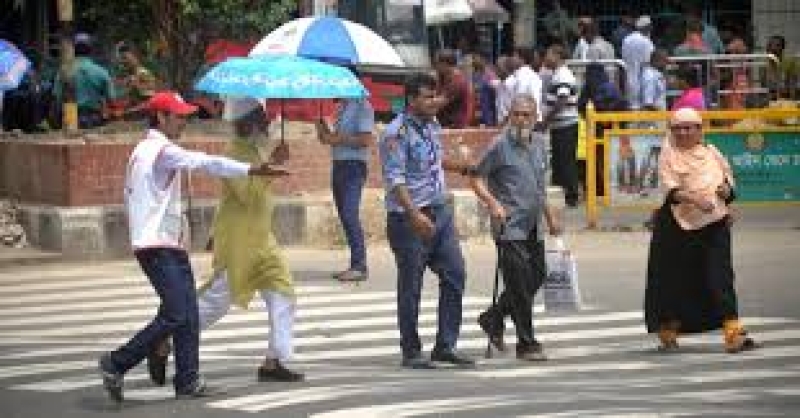- CA Yunus pays homage to Liberation War martyrs on Victory Day |
- Bangladesh capital market extends losing streak for second day |
- Bangladesh celebrates Victory Day Tuesday |
- 'Different govts presented history based on their own ideologies': JU VC |
Pedestrians Most Killed in Dhaka Road Crashes: Study

It was midday on a busy Sunday when a speeding Ramzan Paribahan bus abruptly stopped near Dhaka’s Mouchak Market, closely followed by another from the same company. Both appeared to be racing to pick up passengers—a reckless contest played out daily on the city's congested roads.
Standing near the edge of the road, 45-year-old Synthia Islam was forced to leap onto a broken footpath to avoid being hit. Shaken, she later recounted her narrow escape:
“Most footpaths are unusable, and vehicles drive like they own the road,” she said. “Drivers race to collect more passengers, and we pedestrians end up paying the price—with our lives or limbs.”
Synthia’s experience echoes the findings of a new study conducted by Dhaka North City Corporation (DNCC) and the Bloomberg Philanthropies Initiative for Global Road Safety (BIGRS). It shows that pedestrians accounted for 61% of the 123 road fatalities in Dhaka North in 2023, making them the most vulnerable group on the city's roads.
Grim Statistics from the Study
The research, led by BIGRS Surveillance Coordinator Dr. Tanvir Ibn Ali, analyzed accident data from the Dhaka Metropolitan Police (DMP), covering First Information Reports (FIRs) and complaints filed across 25 DNCC police stations in 2023.
Key findings include:
87% of the fatalities were hit-and-run cases.
Motorcyclists were the second-largest group of victims, comprising 24% of deaths.
83% of those killed were men, but all 20 women who died were pedestrians.
The majority of victims (66%) were aged 20 to 49, the city’s most economically active group.
Most Dangerous Locations
Of the 117 fatal accidents reported, more than half occurred in just seven police station areas. The highest number was recorded in Airport (13 accidents), followed by Khilkhet (11) and Uttara West (10). Accident hotspots included the east side of the Airport Flyover and Mirpur-1 junction.
Hit-and-Runs and High-Risk Hours
The study revealed that most pedestrian fatalities involved buses and trucks, with 87% of incidents being hit-and-runs. More accidents occurred at night than during the day, with 12 deaths reported between 11 PM and midnight alone.
Collision Types
Three major types of collisions led to fatalities:
Pedestrian run-overs: 65%
Rear-end collisions: 37%
Head-on crashes: 6%
Motorcyclist fatalities were predominantly caused by rear-end collisions, often involving trucks.
Who’s Causing the Accidents?
Among vehicles involved:
Buses killed 17 pedestrians and were involved in multiple crashes with other vehicles.
Trucks were responsible for 15 pedestrian deaths and 17 motorbike fatalities.
Four-wheelers, CNGs, and motorbikes also contributed, but to a lesser extent.
Rickshaws were involved in only one reported fatal collision throughout the year.
A Global and Local Crisis
According to the World Health Organization’s Global Road Safety Report 2023, one person dies in a road crash every 26 seconds worldwide. While 60% of the world’s vehicles are in low- and middle-income countries, they account for 92% of global road deaths.
In Bangladesh alone, WHO estimates 86 deaths daily due to road accidents. In March 2025, over 600 people died in crashes nationwide, highlighting the scale of the crisis.
Dhaka’s growing population makes road safety even more urgent. An estimated 23% of the population walks, while 35% travel by bus, placing millions at daily risk.
Recommendations for Safer Streets
To address the crisis, the study recommends:
Revamping footpaths and creating safe pedestrian crossings.
Installing speed bumps, refuge islands, and zebra crossings.
Reducing vehicle speeds, especially for buses and trucks.
Redesigning bus stops and expanding designated zones.
Introducing slow-speed zones near schools and markets.
Additionally, the report emphasizes improving police training to investigate hit-and-run cases effectively. “When drivers know they can get away with it, there’s no deterrent,” the report notes.
Turning Data Into Action
Dr. Tanvir Ibn Ali said the study aimed to turn raw accident data into actionable insights.
“Police collect data for legal processes, but we want to show how it can be used to save lives,” he said. “This helps pinpoint dangerous areas and prioritize solutions.”
A more comprehensive study covering all of Dhaka from 2021 to 2023 is currently underway, aiming to guide long-term urban transport planning and policy.

